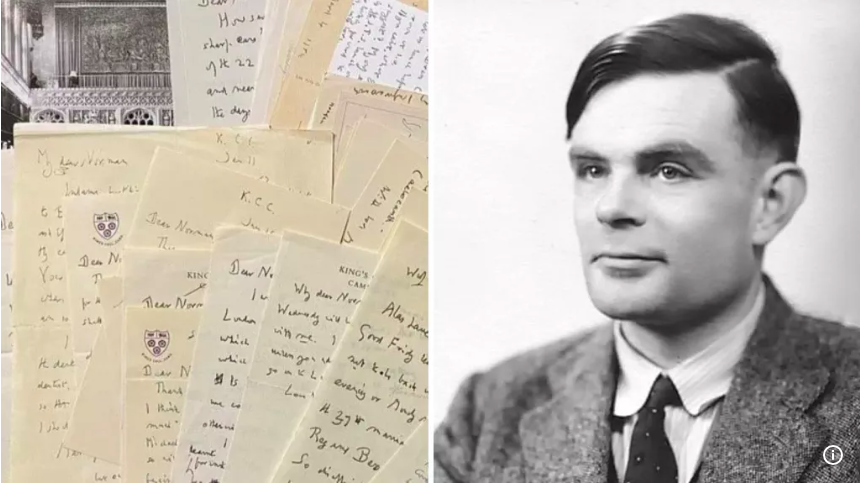World War || Hero Alan Turing’s Lost Scientific Papers Sell for Record £465,400 After Being Saved from Shredder
Quote from Alex Bobby on June 18, 2025, 7:53 AM
Alan Turing’s Rescued Scientific Papers Fetch Record-Breaking Price at UK Auction
A remarkable collection of scientific papers penned by World War II codebreaker and computing pioneer Alan Turing has sold for a staggering £465,400 (€544,400) at an auction in Lichfield, UK — more than three times the expected sale price. These priceless documents, which had been moments away from destruction during a house clearance in London, now stand as a testament to Turing’s enduring legacy and the continued reverence for his work.
A Brush with Oblivion
The papers were discovered in the loft of a property in Bermondsey, London, after the death of Norman Routledge, a mathematician and longtime friend of Turing. When Routledge passed away, his sister unknowingly stored the papers in her attic, nearly consigning them to the shredder during a house clean-up. Instead, they were saved in the nick of time — literally arriving at the auction house in a carrier bag.
“This was the most important archive I’ve ever handled,” said Jim Spencer, Director of Rare Book Auctions at Hansons Auctioneers. “These plain, academic papers were absolutely electrifying – they are the very bedrock of modern computing. Handling them was both humbling and haunting.”
The Works That Shaped Computing
Among the rare documents sold were several of Turing’s most pivotal contributions to the fields of mathematics and computer science:
- “On Computable Numbers” (1936) — Turing’s landmark paper, often credited with laying the foundation for the modern computer. It introduced the concept of a universal computing machine, now known as the Turing Machine. This paper alone fetched £208,000 (€243,000), eclipsing the pre-sale estimates.
- “Systems of Logic Based on Ordinals” (1938) — Turing’s PhD dissertation from Princeton University, signed personally by him, went for £110,500 (€129,200).
- “The Chemical Basis of Morphogenesis” (1952) — His last major published work, exploring how patterns in nature arise, such as the spots on leopards and the spirals of shells, sold for £19,500 (€22,800).
What makes this discovery even more profound is the intellectual and historical weight the papers carry. As Spencer put it, “Knowing the tragic arc of Turing’s life only adds to the emotional weight. He was treated appallingly despite all he had done and yet, here, his ideas remain alive, relevant, and revolutionary.”
Turing’s Legacy Lives On
Alan Turing is revered as one of the greatest scientific minds of the 20th century. He played a central role in cracking the Enigma code, a feat widely credited with shortening World War II and saving millions of lives. His pioneering work not only helped win the war but also laid the foundations for modern computer science and artificial intelligence.
Yet, Turing’s post-war life was marred by persecution. In 1952, he was convicted of gross indecency for homosexual acts, then illegal in the UK. He chose chemical castration over prison, and tragically took his own life two years later at the age of 41.
It wasn’t until 2009 that British Prime Minister Gordon Brown issued a formal apology for Turing’s treatment, calling it “appalling.” In 2013, Queen Elizabeth II granted Turing a posthumous royal pardon. This eventually led to the informal “Alan Turing law” in 2017, which retroactively pardoned thousands of men convicted under historical anti-homosexuality laws.
A Fitting Tribute
The sale of Turing’s papers not only highlights their monetary and intellectual value, but also their symbolic importance in the ongoing quest to honour his memory and contributions. Once nearly discarded, these documents now serve as a powerful reminder of how one man's ideas changed the world — and how society is still coming to terms with the cost of having mistreated him.
Spencer summed it up best: “The papers came within inches of being destroyed, and instead they’ve captured the world’s imagination. It’s a once-in-a-lifetime discovery – not just for collectors, but for the sake of preserving the story of one of the greatest minds in history.”
Looking Ahead
Turing’s story continues to inspire new generations of scientists, activists, and thinkers. As these documents enter private collections or public institutions, their survival ensures that Turing’s legacy remains accessible and celebrated — not as a relic of the past, but as a beacon for the future of science, equality, and innovation.
Conclusion
The astonishing sale of Alan Turing’s rescued scientific papers is far more than an auction headline — it’s a powerful reminder of the enduring legacy of a man whose ideas shaped the digital age. Once nearly lost to a house clearance, these documents now stand as treasured artefact’s of human progress and resilience. Their record-breaking value reflects not only the rarity of the material but also the immense cultural and intellectual weight Turing continues to carry decades after his death.
As the world rediscovers the importance of honouring pioneers like Turing, the recovery of his work is both a celebration and a reckoning — acknowledging the genius that revolutionised modern computing while never forgetting the injustices he endured. In saving his papers, we preserve not just the past, but a vision of the future where innovation, integrity, and inclusion go hand in hand.

Alan Turing’s Rescued Scientific Papers Fetch Record-Breaking Price at UK Auction
A remarkable collection of scientific papers penned by World War II codebreaker and computing pioneer Alan Turing has sold for a staggering £465,400 (€544,400) at an auction in Lichfield, UK — more than three times the expected sale price. These priceless documents, which had been moments away from destruction during a house clearance in London, now stand as a testament to Turing’s enduring legacy and the continued reverence for his work.
A Brush with Oblivion
Register for Tekedia Mini-MBA edition 19 (Feb 9 – May 2, 2026): big discounts for early bird.
Tekedia AI in Business Masterclass opens registrations.
Join Tekedia Capital Syndicate and co-invest in great global startups.
Register for Tekedia AI Lab: From Technical Design to Deployment (next edition begins Jan 24 2026).
The papers were discovered in the loft of a property in Bermondsey, London, after the death of Norman Routledge, a mathematician and longtime friend of Turing. When Routledge passed away, his sister unknowingly stored the papers in her attic, nearly consigning them to the shredder during a house clean-up. Instead, they were saved in the nick of time — literally arriving at the auction house in a carrier bag.
“This was the most important archive I’ve ever handled,” said Jim Spencer, Director of Rare Book Auctions at Hansons Auctioneers. “These plain, academic papers were absolutely electrifying – they are the very bedrock of modern computing. Handling them was both humbling and haunting.”
The Works That Shaped Computing
Among the rare documents sold were several of Turing’s most pivotal contributions to the fields of mathematics and computer science:
- “On Computable Numbers” (1936) — Turing’s landmark paper, often credited with laying the foundation for the modern computer. It introduced the concept of a universal computing machine, now known as the Turing Machine. This paper alone fetched £208,000 (€243,000), eclipsing the pre-sale estimates.
- “Systems of Logic Based on Ordinals” (1938) — Turing’s PhD dissertation from Princeton University, signed personally by him, went for £110,500 (€129,200).
- “The Chemical Basis of Morphogenesis” (1952) — His last major published work, exploring how patterns in nature arise, such as the spots on leopards and the spirals of shells, sold for £19,500 (€22,800).
What makes this discovery even more profound is the intellectual and historical weight the papers carry. As Spencer put it, “Knowing the tragic arc of Turing’s life only adds to the emotional weight. He was treated appallingly despite all he had done and yet, here, his ideas remain alive, relevant, and revolutionary.”
Turing’s Legacy Lives On
Alan Turing is revered as one of the greatest scientific minds of the 20th century. He played a central role in cracking the Enigma code, a feat widely credited with shortening World War II and saving millions of lives. His pioneering work not only helped win the war but also laid the foundations for modern computer science and artificial intelligence.
Yet, Turing’s post-war life was marred by persecution. In 1952, he was convicted of gross indecency for homosexual acts, then illegal in the UK. He chose chemical castration over prison, and tragically took his own life two years later at the age of 41.
It wasn’t until 2009 that British Prime Minister Gordon Brown issued a formal apology for Turing’s treatment, calling it “appalling.” In 2013, Queen Elizabeth II granted Turing a posthumous royal pardon. This eventually led to the informal “Alan Turing law” in 2017, which retroactively pardoned thousands of men convicted under historical anti-homosexuality laws.
A Fitting Tribute
The sale of Turing’s papers not only highlights their monetary and intellectual value, but also their symbolic importance in the ongoing quest to honour his memory and contributions. Once nearly discarded, these documents now serve as a powerful reminder of how one man's ideas changed the world — and how society is still coming to terms with the cost of having mistreated him.
Spencer summed it up best: “The papers came within inches of being destroyed, and instead they’ve captured the world’s imagination. It’s a once-in-a-lifetime discovery – not just for collectors, but for the sake of preserving the story of one of the greatest minds in history.”
Looking Ahead
Turing’s story continues to inspire new generations of scientists, activists, and thinkers. As these documents enter private collections or public institutions, their survival ensures that Turing’s legacy remains accessible and celebrated — not as a relic of the past, but as a beacon for the future of science, equality, and innovation.
Conclusion
The astonishing sale of Alan Turing’s rescued scientific papers is far more than an auction headline — it’s a powerful reminder of the enduring legacy of a man whose ideas shaped the digital age. Once nearly lost to a house clearance, these documents now stand as treasured artefact’s of human progress and resilience. Their record-breaking value reflects not only the rarity of the material but also the immense cultural and intellectual weight Turing continues to carry decades after his death.
As the world rediscovers the importance of honouring pioneers like Turing, the recovery of his work is both a celebration and a reckoning — acknowledging the genius that revolutionised modern computing while never forgetting the injustices he endured. In saving his papers, we preserve not just the past, but a vision of the future where innovation, integrity, and inclusion go hand in hand.
Uploaded files:Share this:
- Click to share on Facebook (Opens in new window) Facebook
- Click to share on X (Opens in new window) X
- Click to share on WhatsApp (Opens in new window) WhatsApp
- Click to share on LinkedIn (Opens in new window) LinkedIn
- Click to email a link to a friend (Opens in new window) Email
- Click to print (Opens in new window) Print



